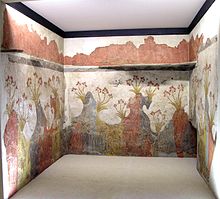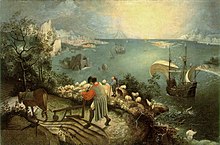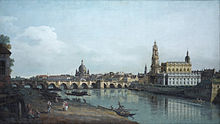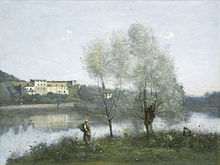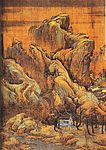Landscape painting
In addition to the history painting , the portrait , the genre painting and the still life, landscape painting is a genre of representational painting .
overview

Landscape painting includes the representation of sections from the space determined by nature as well as by human hands. The subject of the picture can be concrete and idealized natural landscapes from hill country to high mountains , for example seascapes, rivers , mountain lakes and summit formations or motifs on the seashore .
Frequent motifs are also cultural landscapes - such as views of cities and architecture (see vedute ) - as well as garden art and park landscapes , industrial motifs and factory landscapes . Evidence for the depiction of landscape motifs in painting has existed in ancient Egypt, Mesopotamia and Europe since ancient Greece . The latter, however, have only come down to us through written sources.
Landscape painting is an important branch of the fine arts in China and Japan , while the pre-Columbian cultures of South America did not know about landscape painting. In Islamic art there is landscape painting as part of the highly developed book illumination of Persia and India (see Mughal art ).
The term landscape
The word landscape has its roots in Old High German. Since the 12th century it has been the term for the entirety of the inhabitants of a country, which was later extended to include the estates assembly of a country (cf. Landschaftsverband ). It was only in the late Middle Ages that the term was narrowed down to the purely geographical meaning that is still used today.
In the painting of the Renaissance , the term landscape became established as a term for the representation of a section from a natural area. Already in the 16th century it was used in the same context as landscape in English and landschap in Dutch. In the Romance-speaking area, the French paysage and the Spanish paisaje arose at the same time and with the same meaning , while in Italian the word paese was used both for a real landscape and for a landscape depicted in a picture. The word paesaggio , which today designates a landscape in Italian, only gradually gained acceptance.
Antiquity
Greece
Almost nothing has survived from the Greek panel and fresco painting . We have knowledge of this from Greek authors such as Pausanias and above all from Roman commentaries on these and lost writings. Early evidence of landscape representation comes from the area of the Cretan-Mycenaean culture . Fragments of frescoes have been preserved, on which, in addition to plant and animal motifs, hints of terrain lines and architecturally structured rooms can be seen. Landscapes were suggested in connection with mythological and historical themes. Pausanias reports on panel and wall paintings in which the painters depicted landscapes with the help of linear perspective and shadow painting. The best known among the painters of this period (480-460 BC) was Polygnot of Thasos , whose pictures were in the Stoa Poikile of Athens and in Delphi. Wall frescoes from the diver's grave near Paestum (Poseidonia) in southern Italy, on which trees, architecture and terrain lines are depicted, have been preserved from the 5th century BC . From Zeuxis of Herakleia , the pupil of Apollodorus of Athens, it is known that he dealt with the representation of light and shadow as a means of creating the illusion of spatial depth and that he painted idylls .
The ancient theater used in the Skenografie interchangeable screens on stage building and the proscenium . These were each painted with motifs that matched the three genres of Greek drama. Tragedy and comedy were played against an architectural backdrop, while the satyr play took place in the forest or in the garden. According to Vitruvius , trees, mountains, grottos and other objects were shown on the sets of the satyr play, such as those found in the country. The first to try to create an illusion of space in stage painting by foreshortening of perspective was Agatharch of Samos .
Rome
In Rome, the principle of Greek stage decoration was adopted for the Roman theater. This Greek stage painting in turn influenced the art of Roman wall painting , as it is preserved in the villas in Pompeii or Herculaneum . However, the tendency pursued in Greece of spatial coverage of the landscape was not continued. Pliny the Elder (XXXV, 116–117) explicitly mentions Spurius Tadius as the inventor of landscape painting. During the transition from late Roman to early Christian art, the plasticity of the figures and the illusion of space only played a subordinate role.
middle Ages
One cannot speak of landscape painting in the narrower sense until the beginning of the late Middle Ages. Indications of terrain formations or architectures in the picture serve to localize the depicted scenes or are carriers of meaning within the framework of the overall concept of a picture and not the representation of an ideal or specific geographical area.
A wavy line indicates the river Jordan at the baptism of Christ , a terrain line with trees and flowers can be read as a symbol for paradise, a fortified city as a reference to the heavenly Jerusalem .
With the end of the Middle Ages, man's view of nature changed. In painting, instead of a mode of representation aimed at the typical through abbreviations, there was an effort to capture things from nature as precisely as possible in their individuality and to represent them graphically. The painters no longer orientated themselves to the pattern books handed down over generations, rather they tried to capture the reality of their time and their world through close observation. This applies not only to the new view of people, but also to a new - aesthetic - view of the landscape.
Simone Martini was probably the first to depict landscapes directly from nature, as topographical portraits. He painted four castles in the Palazzo Pubblico in Siena and was demonstrably there himself on behalf of the Comune. These are topographical representations that show the Sienese conquests and that should be distinguishable from one another. Only the large fresco from 1330 with Guidoriccio da Fogliano is preserved. It shows the town of Montemassi with its castle, the portrayal of which can still be checked today.
Petrarch's famous ascent of Mont Ventoux on April 6, 1336 and the frescoes for the Palazzo Pubblico in Siena, begun by Lorenzetti around the same time, are exemplary for the emergence of this new perspective . Upon reaching the summit, Petrarch was overwhelmed by the beauty of the world that spreads before him. He likes the “earthly taste”. At this moment the world is no longer seen as a hostile and perishable one for humans, which is only a transit station into a world beyond, but as one that can be marveled at in its beauty and grandeur.
Lorenzetti's fresco The Good Government unfolds in front of the viewer a panorama of the national territory of Siena, on which the work of an entire year is shown side by side. You can see the typical representatives of the municipality: nobles, craftsmen and farmers with their typical activities. A whole inventory of the possible uses of cultivated land is presented, namely the city with the diversity of its buildings and inhabitants as well as forests, orchards, vineyards, meadows and fields. This interest in a “systematic” and rational recording of landscape in a public fresco goes hand in hand with the simultaneous introduction of cadastre in the municipalities of Italy.

Evidence of a depiction of the landscape as a background for a picture narration has appeared since the end of the Middle Ages with the transition to the Renaissance in the Netherlands. In calendars and books of hours there is a great variety of landscapes, be it on the monthly pictures of the calendars or as backgrounds of biblical or historical scenes. Excellent examples of Burgundian-Dutch miniature painting are the six books of hours for the Duke of Berry, the most famous of which is the Très Riches Heures with illustrations by the Limburg brothers. In the design of depth and landscape, the first attempts to depict the atmospheric or the special appearance of the times of day in the picture, book illumination is far ahead of its time. It is only with the beginning of oil painting that the technical prerequisites are made available for panel painting to understand the new developments in book illumination in panel painting.

An example is the Dutchman Jan van Eyck , who initiated a decisive turning point in European panel painting. He initially worked as an illuminator - two of the sheets from the Duc de Berry's book of hours are his, the Turin-Milan Book of Hours is by his hand - and as a panel painter. His famous Ghent Altarpiece shows in the lower part a gathering of saints adoring the Lamb, embedded in a paradisiacal ideal landscape that extends to a horizon that appears far away.
The achievements of Dutch oil painting in their possibilities for the differentiated representation of lighting effects and atmosphere were quickly known and used in Italy due to the close trade relations between Italy and the Netherlands.
Renaissance
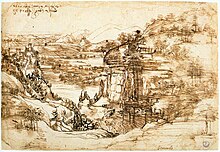
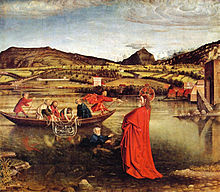
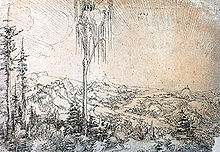
With the beginning of the Renaissance and the renewal of art in Italy, by Vasari as renascità as early as Cimabue († after 1302) and Giotto († 1337), there was a momentous turn in intellectual history, which with the rise of individualism, a new appropriation of antiquity and a turn to scientific exploration of the world.
For painting, with the linear perspective discovered and described by Brunelleschi and others, new prerequisites were created for landscape painting as well, for depicting the three-dimensional space of a landscape on one image plane. Technical devices such as the camera obscura or the velum , an aid for perspective representation, were used. Piero della Francesca's tract De prospettiva pigendi , the first precise mathematical description of the central perspective , appeared around 1470 . The aerial perspective, a phenomenon that can already be observed in ancient painting , has been systematically researched by painters, above all Leonardo da Vinci . The oil painting developed in the Netherlands finally opened up new possibilities for capturing spatial effect, atmosphere and of the landscape painting through the luminous brilliance of the colors, through the finest color gradations, translucent glazes and a new and fundamental attention to the play of light and shadow in the picture Light and air phenomena.
With the early Renaissance, the gold grounds of medieval images of saints were finally replaced by landscapes, initially as a backdrop-like arrangement of individual motifs, as with Giotto, later as a uniform background.
In the first third of the 16th century, a new, previously unknown sense of nature emerged north of the Alps. The nature received in images of Donauschule an independent rank; Studies of nature without depictions of people are not uncommon. The first pure landscape painting without any figures is the Danube landscape with Wörth Castle , created around 1522 by a painter from the Danube School, Albrecht Altdorfer . Early examples from Northern Europe for the reproduction of a specific landscape - Lake Geneva - are The wonderful fishing course of Konrad Witz - or a realistic depiction of moving water on the Christophoros from around 1435 by the same painter.
In Venice as well as in Florence, the suggestions from the north and the discoveries of perspective in Italy were reflected in different ways. In Piero della Francesca's Montefeltro diptych, the viewer looks from a bird's eye view of a vast, light landscape, with the portrait and landscape on different and unconnected image levels. Leonardo da Vinci († 1519), who also made the first pure landscape drawing , did not depict any real nature as the background for some of his paintings, such as the Madonna of the Rocks , the Mona Lisa or Anna Selbdritt , all in the Louvre in Paris Rather, landscapes are a kind of overview of the elementary manifestations of nature: earth, water, rock and air, proximity and distance, warmth and cold.
Antonello da Messina († 1479), who stayed in Venice around 1475, is considered a mediator of Dutch painting in Venice . Dürer's woodcuts were just as momentous for the depictions of landscapes by Venetian painters , while his landscape watercolors from his trip to Italy were not published and had no public effect because of their function as working sketches. With the Venetians Bellini , Giorgione and Tizian , the amalgamation of figures and landscape, light and color, characteristic of Venetian painting, developed into an atmospheric picture unit of poetic and lyrical quality. Giorgione painted the first picture with his thunderstorm around 1515, in which the figures are moved to the edge and landscape becomes the subject of the picture.
From the middle of the 16th century, landscape painting began to flourish in the Netherlands, which is associated with the names Joachim Patinir , Gerard David , Hieronymus Bosch and Pieter Brueghel . Joachim Patinier († 1524) created the overview-like world landscapes , in which biblical or mythological groups of figures almost only take the rank of staffage figures. In Breughel's painting The Fall of Icarus from 1558, the actual - mythological - theme has been pushed to the extreme in favor of the depiction of a wide landscape in the light of the morning sun, to whose harmonious harmony the active person also belongs.
17th century

Towards the end of the 16th century there was a re-establishment of the landscape representation in Bologna, among others through the Carracci under the influence of Venetian painting. Annibale Carracci changed his strict mannerism- oriented painting style and combined a precise study of nature with a Venetian color scheme. In 1595 he moved his workshop to Rome. His painting Fischfang was made in 1596 , and its dramatic lighting, expressive colors and movement of the figures refer to the Baroque . His style of painting had a great influence on his fellow Roman painters and, with regard to landscape painting, in particular on Nicolas Poussin and Claude Lorrain .
Until the early 17th century, landscapes in panel painting and frescoes were limited to the background. Landscape painting was further developed in Rome by a group of painters led by Adam Elsheimer from Frankfurt .


One of the group was the Dutchman Paul Bril , who had been in Rome since 1582. He specialized in idealized landscapes in which selected elements of real landscapes are composed to form an ideal landscape. Scenes in the foreground or repoussoirs made of trees and architecture open up a view into the far distance. People in the pictures are only accessories . From 1600 onwards, Elsheimer from Frankfurt, who was friends with Bril, also lived in Rome. Elsheimer painted small-format landscape pictures on copper ground full of tiny details, enriched with mythological or biblical scenes, which are characterized by a metallic color. His handling of different light sources in the picture, for example in his famous night play The Flight to Egypt from 1609, is an essential means for the effect of his landscapes.
The pictures of Annibale Carracci, Adam Elsheimer and Paul Brils were of fundamental importance for the landscapes of Nicolas Poussin and Claude Lorrain.
Heroic and idyllic Arcadian landscapes


Paintings that are built according to strictly rational principles, whose idealized landscape are bathed in a mild light, whose architecture is taken from classical antiquity and whose figures preferably come from ancient mythology or the world of the Bible, are referred to as heroic landscapes designated. The main representative of this type of landscape painting was the French Nicolas Poussin , who had lived in Rome since 1624 .
The second outstanding landscape painter in Rome was Claude Lorrain , also from France, who had lived there since 1613. Lorrain's pictures, also built according to rational formal principles, with rural or biblical staff as staffage figures, the typical repoussoir made of wood or ancient architecture, which often open up a view of a sea that shimmers in the glow of the evening or morning sun, are because of their cheerfulness Basic mood called idyllic Arcadian landscapes .
Both painters were considered role models for classicist landscape painting and for the painters of heroic landscapes in the 19th century. In the early 19th century this term was adopted for dramatically moving landscapes and for high mountain landscapes. Poussin's brother-in-law Gaspard Dughet , on the other hand, concentrated on the reproduction of real landscapes from the Roman Campagna and the area around Tivoli, while the Neapolitan Salvator Rosa cultivated a preference for picturesque and imaginative landscapes, in which one could recognize a proximity to romantic landscape painting.
Dutch landscape painting
At the turn of the 17th century, the landscape, previously only the scene of mythological or historical scenes, became a subject of its own. There were profound social changes during the Dutch Golden Age . Due to the growing prosperity in broad circles, after the church ceased to be the principal and the dominance of Protestantism in the northern Netherlands, there was an increased demand for pictures by the bourgeoisie for private use. The interest in landscape images went hand in hand with a fundamental tendency to observe and explore nature, the blossoming of cartography , for which there was a strong need due to the growth of Dutch overseas trade, the secure mastery of perspective representation and advances in natural sciences and technology through which new resources were available. In the field of cartography and land surveying , mathematicians and geodesists (land surveyors), cartographers, painters and engravers worked hand in hand. Thus, maps of the time often on the edge with vistas framed, famous example of Vermeer Allegory of Painting . Maps and nautical maps were published by the same printers as were reproductions of landscape paintings in copperplate engravings or etchings . The trade in reproductions was crucial to the rapid spread of Dutch landscape painting across Europe.

The genre soon fanned out into a number of subjects that individual painters focused on. There were specialists for fantasy landscapes, Italianizing landscapes, mountain , forest, coastal and river landscapes, seascapes , topographical landscapes, winter scenes, etc. The thematically often unspectacular images are characterized by a rich range of color gradations, a fine aerial perspective and differentiated light effects that determine the basic mood of every painting. A charge comparable to the still lifes of the time with symbolic , allegorical or emblematic , as well as biblical or moralizing meanings, has also been proven in many cases for the landscapes, in which hardly any human figures are completely absent. The symbolically interpretable repertoire of motifs includes natural phenomena that, as in contemporary natural poetry, refer to the cycle of life and its transience or address the topic of the (life) journey with hikers and pilgrims, often only inserted in tiny dimensions.
The beginnings of landscape painting as an independent genre can be dated in Flanders with Patinier's world landscapes , in which the landscape is the main theme and not the figures. In addition to paintings such as the seasons or the fall of Icarus , Pieter Brueghel also made drawings from nature, both during his trip to Italy and in Brabant. In addition to the impetus emanating from Flanders, influences from Italy became effective through the reproductions of Adam Elsheimer's pictures by the Utrecht copper engraver Hendrick Goudt .
With Esaias van de Velde , Pieter de Molijn , Jan van Goyen and Salomon van Ruisdael , a naturalistic conception of the picture was strengthened together with a preference for simpler motifs, uniform composition and an increased attention to the appearance of the cloudy sky and the changing lighting in the country. In terms of color choice, between 1625 and 1650 there was a preference for monochrome pictures in blue, green and earth tones.

The great landscape painters of the late 17th century, Jacob van Ruisdael and Aelbert Cuyp, reveal Italian influences both in the composition and in the lighting of the pictures. Ruisdael's often gloomy and melancholy landscapes with their dramatic cloud formations, dying trees and cascading waterfalls become expressions of subjective feelings, a reason for the high esteem of his pictures by the romantics. Cuyp's idealized images, on the other hand, are filled with a cheerful, pastoral mood, an abundance of warm light. They often show small rural scenes. Ruisdael's pupil was Meindest Hobbema , who specialized in forest scenes and water mills. One of the most famous and often reproduced pictures of Dutch landscape painting is his Allee von Middelharnis from 1689.
Painters in the southern Netherlands, like Rubens in the last years of his life, painted landscapes in warm and lively colors. Rembrandt devoted himself intensively to depicting landscapes in his etchings since 1640.
Watteau , embarkation for Kythera , 1717/18, Berlin version; Charlottenburg Palace, Berlin
18th century
With the 18th century the interest in landscape painting among collectors and enthusiasts decreased, but the demand for topographically accurate representations of certain places increased. The Venetian vedute painters Bellotto , Canaletto and Guardi and Luigi Vanvitelli, who worked in Rome, should be mentioned here . As a landscape painter, Guardi cultivated the genre of capriccios , landscapes that are composed of invented and real parts to form an ideal composition. The delicate and airy landscape backgrounds in Watteau's and Fragonard's paintings are characteristic of French painting of the time .
In 18th century England, landscape painting was often based on Italian models, particularly Claude Lorrain.
After his stay in Rome, Richard Wilson painted atmospheric, melancholy landscapes, as did John Robert Cozens , the latter with a tendency towards the idyllic and Arcadian. In the late 18th century, painters developed an interest in the sublime in nature. Burke's 1756 study of the Sublime ( Inquiry into the Origin of our Ideas of the Sublime and the Beautiful ) led to intellectual and artistic examination of his ideas not only in England, but also in the aesthetic debate in Germany.
The English landscape garden
In the middle to the end of the 18th century, a new garden art developed in England in deliberate contrast to the architectural garden of France , the architects of which were based on pictures by Lorrain and Poussin and blurred the line between the garden and the open landscape. Instead of garden lines, axes and symmetries, there was now natural tree growth and the idyllic ruins inspired by Romanticism. As Adrian von Buttlar puts it, “garden scenes are composed according to the rules of landscape painting with masses, spaces, color, light and shadow as well as repoussoirs that frame the overall picture”. Main representatives of this type of landscape garden were William Kent (1664-1748), Lancelot Brown (1715-1783) and William Chambers (1723-1796).
19th century
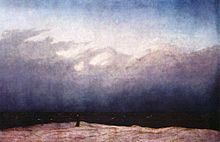

Around the turn of the century, both a new attitude towards a subjective experience of the world and a change in the perception of phenomena were heralded in the visual arts, as can be seen in pictures by Turner , CD Friedrich or Delacroix . The paradigm shift of modernity is not least visible in the representation of landscape.
Artists like Gustave Courbet rejected the traditional principles and norms of painting, as they had been developed in the art academies since the Renaissance , and turned to new topics from the bourgeois milieu and the world of work. The brown “academy tone” of pictures became obsolete, both the perspective representation and a mimetic imitation of nature were rejected. Not only the impressionists now chose bright and garish colors.
The interest shifted from the motif to the painting style. Cézanne no longer understood the picture in the Alberti sense as a window to the world, no three-dimensional space is simulated on the flat surface, the picture is rather a two-dimensional field in which the order of shapes and colors is relevant. The image itself is a parallel reality to the reality of the world and not its depiction.
Towards the end of the century there was an increasing tendency towards a subjective interpretation of the world and towards the dominance of personal handwriting, as can be seen in the expressive landscapes of Van Gogh , as well as an increased variety of artistic perspectives, a hallmark of modern painting.
Classicism and Romanticism


At the beginning of the 19th century, the public's interest was increasingly directed towards landscape painting. Inspired by the writings of Jean-Jacques Rousseau , in which a new sensitivity for nature and its effect on the mental constitution of man can be recognized, poets and artists of the Romantic period saw in nature a source of passionate feeling and a metaphysical dimension. After questioning traditional beliefs in the Age of Enlightenment , painters such as Caspar David Friedrich sought a transcendental relationship in nature and landscape. After the loss of old ideals, it should be the task of art to make utopias visible and to create a new model and ideal. His Tetschen Altar from 1808, which triggered a heated debate in literary and philosophical circles about the possible religious function of landscape paintings, is an example of this .
Romantic landscapes aim at triggering emotional processes, at a picture magic that is supposed to bring about an inner dialogue between viewer and picture.

At the same time, artists such as Koch , Reinhart , Hackert and Wolf , who were committed to classicism , painted . They were based on the old models Poussin and Claude Lorrain, since no landscape paintings were known from antiquity. These painters saw in their pictures the task of making an ideal world plan visible in the sense of a revival of the ancient spirit.
Romantic paintings had an effect on landscape painters in England and the USA. Painters like William Blake and Turner shared Friedrich's interest in a symbolic charge of landscapes. Turner dealt with the effects of light and space in his countless landscape sketches and his expressive and intensely colored paintings. In the United States, the painters at the Hudson River School referred to German romantic painting.
realism
In the early 30s of the 19th century, painters in England , Germany and France showed an increased interest in realistic landscape representations. Examples for England are Richard Parkes Bonington and John Constable with his rural motifs and his cloud images, for Switzerland Johann Gottfried Steffan and for Germany Adolph Menzel , who was one of the first to paint industrial landscapes, or Karl Blechen with his turning away from romantic emotions and his preference for grandiose light and color effects in nature. The Belgian Charles Leickert , based in the Netherlands, specialized in winter landscapes.
Biedermeier artists such as Karl Spitzweg or, towards the end of the century, painters such as Hans Thoma , Wilhelm Leibl or Fritz von Uhde , painted their pictures under the impression of French open-air painting . Camille Corot , one of the first plein-air painters, refined the depiction of light and atmosphere in his pictures, but stuck to the composition of ideal landscapes, while the realism of Gustave Courbet did not omit the repulsive and ugly in the pictures.
The Düsseldorf painter J. Metzler , who painted almost all important landscapes from the Lower Rhine region, is in the Dutch tradition .
The Barbizon School
The Barbizon School , whose members went out into the great outdoors and painted their pictures there instead of - as was customary in the past - based on sketches from nature in the studio, had an extraordinarily great influence on the painting of the coming generation, especially the Impressionists . The aim of the Barbizon painters was to realistically and objectively reproduce nature or a concrete landscape with all its different lighting situations.
impressionism

In impressionism , painting becomes light and airy, determined by the play of light on nature. The colors flow into one another. You no longer just paint in the studio , but go outside (open-air painting, or "plenair" painting) in order to directly expose yourself to the impressions of the surroundings while painting. The perception of things becomes more important than their meaning . The best-known representative of this type of painting is Claude Monet .
20th century
The landscape painting of the 20th century offers the viewer a multifaceted picture of confusing diversity as the art of the present in general. Ariane Grigoteit sees landscape in the various concepts of the artists basically available. She suspects one cause in the new scientific knowledge at the beginning of the 20th century, in which nature lost its reliability. “The landscape motif disintegrated into external appearance and internal forces. Neither new engineering achievements, scientific knowledge, nor a view of the individual's inner nature could provide explanations for natural existence. The alienation between man and nature grew, as did the fear of the end of nature […] Landscape was available in the most varied of individual models. ”(In: Ariane Grigoteit: Landscapes of a Century from the Deutsche Bank Collection. Frankfurt a. M . 1999, p. 39.)
The scope of the examination of the landscape phenomenon ranges from the late impressionist pictures of a Liebermann or Slevogt , the Fauves in France, the search for pristine nature in exotic countries with Gauguin , Pechstein , Nolde or Kirchner , to the gray cloud images or photorealistic landscapes of Gerhard Richter or Helmut Ditsch , the melancholy oil paintings by Fritz Lattke and the works of an Anselm Kiefer , who in his painting Märkisches Land carved place names from Fontane's walks through the Mark Brandenburg into the oil paint sprinkled with sand . In the mid-1960s, Hans-Jürgen Kleinhammes and Werner Nöfer developed a pictorial direction under the programmatic term "New Landscape", which only used landscape fragments and a pictorial language reduced to signet-like and technoid abstraction.
The range of landscapes in the broadest sense in the USA is just as wide. There are the colorful, striking Grand Canyon pictures of a Hockney alongside post-romantic or surrealistic painters such as Paul Nash , Graham Sutherland or Grant Wood , with his melancholy pictures from the Midwest. Abstract Expressionist painters like Clyfford Still or Jackson Pollock suggest in their pictures at least the size and charisma of a sublime landscape. Mark Rothko's pictures are attributed by some interpreters to a reflection on boundaries and infinity , similar to Caspar David Friedrich .

The relationship between landscape painting and photography is diverse. Photos by Atget († 1927), who documented Paris at the turn of the century in his extensive work, served his painter friends as templates. Others, such as Ansel Adams († 1984) in his black-and-white photographs from the Rocky Mountains, made use of the visual aesthetics of romantic painting, while Jeff Wall was occasionally inspired by models and storytelling from art history in his staging.
Others intervened in existing natural or cultural landscapes, such as Beuys , of which there are also a number of landscape watercolors, with his project 7000 Oaks in Kassel on the occasion of Documenta 7, or Christo and Jeanne-Claude , the trees in Berower Park in Switzerland wrapped up, gave Central Park in New York a strange poetic effect by flagging it with orange cloths and the American Land Art artist Robert Smithson († 1973), who created his Spiral Jetty in the Great Salt Lake in Utah and then used it to the work of nature left.
The question of the importance of landscape painting in the digital age dealt Adam Jankowski , who seeks "to preserve landscape as a motive and to renew the landscape from its tradition," the (Annemarie Freybourg)
Asia
Landscape painting plays a very important role in East Asia . After a high point in Chinese landscape painting in the 8th century, it was further developed in the monochrome masterpieces of the 11th and 12th centuries (Fan Kuan, Guō Xī , Xu Daoning), which strived for realistic rendering . From the 13th century literary painting flourished, which saw landscape painting as an expression of personality. In Japan, landscape painting developed from Buddhist painting between the 8th and 11th centuries; The ink landscapes of the monk painters (Minsho, Shiubun, Sesshu Toyo ) from the 14th to 16th centuries can still be seen as an expression of Zen . It was not until the end of the 16th century that Japanese landscape painting became an independent art movement in a markedly decorative style.
A well-known Japanese artist was Utagawa Hiroshige , who made numerous woodcuts with Japanese landscapes at the end of the Edo period . The Japanese language knows different words that describe the pictorial representation of landscapes. On the one hand Japanese 風景画 Fûkeiga (landscape painting) versus Japanese 花鳥画 Kachōga (flower and bird pictures) and Japanese 山水画 Sansui-ga (landscape painting).
The term Fûkeiga comes from the Meiji period at the end of the 18th century. Sansui-ga (Shan-shui hua) was previously in use, a term that was introduced from China in the 13th century with Zen Buddhism , from which the Japanese style developed. In China, Fukei had a special relationship with the mountains and water. As early as the 5th century BC, we described the special role of mountains and rivers, which were considered sacred places in East Asia, in Confucius' Lun-Yu in which the gods dwell.

The Japanese artists associated the term Fûkeiga with the atmospheric and light-flooded Dutch landscape painting of the 17th century or the French Impressionists of the 19th century, while Sansui-ga refers more to traditional Japanese landscape painting, which is also referred to as San-en-ho (heights -, depth, and width).
Guō Xī described this technique as follows: “There are three types of composition for painting a mountain. If you look up to the mountain top from your foot, it is called 'heights distance'. If you look down from behind the mountain from the mountain in front, it is called 'deep distance'. If you look over the distant mountain from the nearby mountain, it is called 'far distance'. 'Heights distant' offers a strict, rugged impression, 'deep distant' a deeper view lying one above the other and 'wide distant' a calm, indistinct foresight. "
Ink drawing, Sesshu Toyo , Japan 15th century
Digital collections
- Landscape painting masterpieces , Directmedia Publishing , Berlin 2007, KDB Volume 21, CD-ROM, ISBN 978-3-89853-321-8
See also
literature
Overall representations
- Rolf Wedewer : Landscape painting between dream and reality . DuMont, Cologne 1978, ISBN 3-7701-0354-8
- Nils Büttner : History of landscape painting. Hirmer, Munich 2006, ISBN 3-7774-2925-2 .
- Landscape. In: Karlheinz Barck u. a. (Ed.): Basic aesthetic terms. Studies on a Historical Dictionary. 3. Edition. Metzler, Stuttgart 2001, ISBN 3-476-01657-9 , pp. 617-695.
- Silke von Berswordt-Wallrabe, Volker Rattemeyer (Ed.): Weltsichten. Landscape in Art since the 17th Century , Bochum 2010, ISBN 978-3-941778-01-6
- Norbert Schneider : History of landscape painting - from the late Middle Ages to Romanticism. 2nd Edition. Scientific Book Society, Darmstadt 2009, ISBN 978-3-89678-672-2 .
- Erich Steingräber : Two thousand years of European landscape painting. Hirmer, Munich 1985, ISBN 3-7774-3570-8 .
- Wolfgang Klien : The triumphant advance of landscape painting. A history of the development of landscape painting in Europe . Jahn & Ernst, Hamburg 1990.
- Norbert Wolf : landscape painting. Taschen, Cologne u. a. 2008, ISBN 978-3-8228-5463-1 .
Individual representations
- Reiner Bentmann / Heinz Ohff: "New Landscape ". Edition Herzog, Berlin 1971
- Heinz Spielmann "The New Landscape". Monograph on a new concept of landscape . Traveling exhibition at BAT Hamburg 1976.
- Svetlana Alpers : Art as a Description. Dutch painting of the 17th century. Dumont, Cologne 1998, ISBN 3-7701-4445-7 .
- Oskar Bätschmann : Distance from nature. Landscape painting 1750–1920. DuMont, Cologne 1989, ISBN 3-7701-2193-7 .
- Nils Büttner: The invention of the landscape. Cosmography and Landscape Art in the Age of Bruegel. Vandenhoeck & Ruprecht, Göttingen 2000, ISBN 3-525-47900-X . ( digi.ub.uni-heidelberg.de ).
- Adrian von Buttlar : The landscape garden, garden art of classicism and romanticism. Dumont, Cologne 1989, ISBN 3-7701-2088-4 .
- Bastian Eclercy (Ed.): Nah und Fern. Landscape painting from Brueghel to Corinth. Wienand, Cologne 2011, ISBN 978-3-86832-060-2 , with DVD.
- Barbara Eschenburg: Landscape in German Painting - from the late Middle Ages to today. CH Beck, Munich, 1987, ISBN 3-406-32044-9 .
- Uta Feldges: Landscape as a topographical portrait. The restart of European landscape painting in Siena. Benteli, Bern 1980, ISBN 3-7165-0338-X .
- Günter Hartmann: The ruins in the landscape garden: their importance for early historicism and romantic landscape painting. (= Green Series, Volume 3) Wernersche Verlagsgesellschaft , Worms 1981. ISBN 978-3-88462-007-6
- Tanja Michalsky : projection and imagination. The Dutch Landscape of the Early Modern Age in the Discourse of Geography and Painting. Fink, Munich 2011, ISBN 978-3-7705-5043-2 .
- Götz Pochat: Figure and Landscape. A historical interpretation of landscape painting from ancient times to the Renaissance. De Gruyter, Berlin 1973, ISBN 3-11-004104-9 .
- Max Sauerlandt : The quiet garden. German painter of the first half of the 19th century . Langewiesche, Düsseldorf 1908 online - Internet Archive
- Martin Warnke : Political Landscape. On the art history of nature. Hanser, Munich 1992, ISBN 3-446-17216-5 .
Web links
- Considerations on landscape painting
- European city and landscape representations of the 16th and 17th centuries in the University and City Library of Cologne
- Chronology of the history of landscape painting
Individual evidence
- ↑ … et nunc terrenum aliquid saperem… quoted from Francesco Petrarca: The ascent of Mont Ventoux. Lt./Dt. Stuttgart 1999, p. 22 and 23.
- ^ Wilfried Wiegand: Ruisdael Studies , Hamburg 1971
- ↑ Hans-Joachim Raupp: On the importance of theme and symbol for Dutch landscape painting of the 17th century . In: Yearbook of the State Art Collections in Baden-Württemberg, 17, 1980, pp. 85–110.
- ↑ kleinsassen.de Review by Bea Nolte-Schunck: Three heavyweights in artistic dialogue.
- ↑ Mikhail Uspensky: Hiroshige. Parkstone International, New York 2011, ISBN 978-1-78042-243-5 (Japanese landscape painting by Utagawa Hiroshige).
- ↑ Hokusai Katsushika, Seiji Nagata: 風景画 - Fûkeiga . Shûeisha, Tokyo 1990, ISBN 4-08-597002-X (Japanese).
- ↑ Hokusai Katsushika, Seiji Nagata: 花鳥画 - Kachōga . Shûeisha, Tokyo 1990, ISBN 4-08-597001-1 (Japanese).
- ↑ a b c Importance of landscape painting. (No longer available online.) Canandanann.nl, March 6, 2015, archived from the original on November 11, 2016 ; accessed on November 11, 2016 . Info: The archive link was inserted automatically and has not yet been checked. Please check the original and archive link according to the instructions and then remove this notice.

